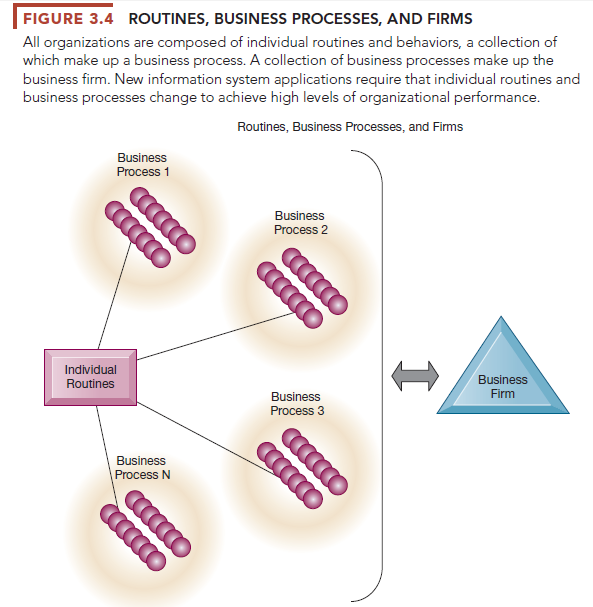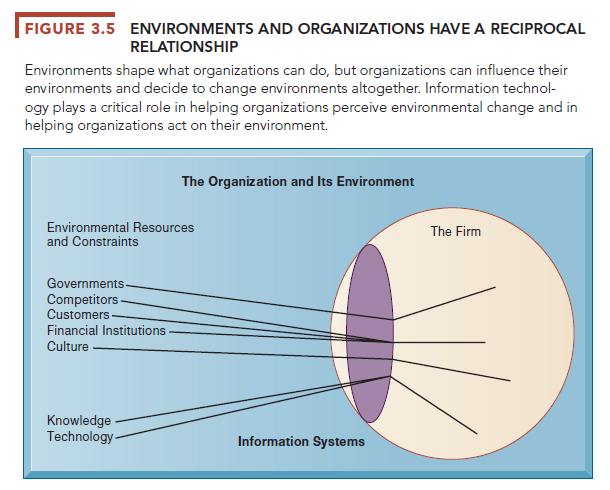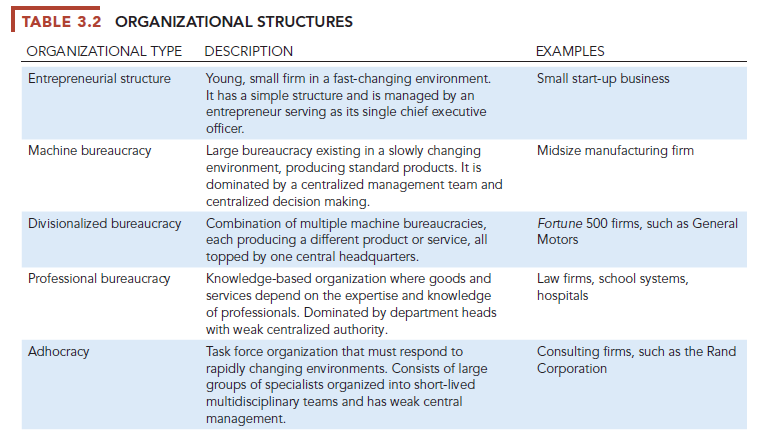All modern organizations share certain characteristics. They are bureaucracies with clear-cut divisions of labor and specialization. Organizations arrange specialists in a hierarchy of authority in which everyone is accountable to someone and authority is limited to specific actions governed by abstract rules or procedures. These rules create a system of impartial and universal decision making. Organizations try to hire and promote employees on the basis of technical qualifications and professionalism (not personal connections). The organization is devoted to the principle of efficiency: maximizing output using limited inputs. Other features of organizations include their business processes, organizational culture, organizational politics, surrounding environments, structure, goals, constituencies, and leadership styles. All of these features affect the kinds of information systems used by organizations.
1. Routines and Business Processes
All organizations, including business firms, become very efficient over time because individuals in the firm develop routines for producing goods and services. Routines—sometimes called standard operating procedures—are precise rules, procedures, and practices that have been developed to cope with virtually all expected situations. As employees learn these routines, they become highly productive and efficient, and the firm is able to reduce its costs over time as efficiency increases. For instance, when you visit a doctor’s office, receptionists have a well-developed set of routines for gathering basic information from you, nurses have a different set of routines for preparing you for an interview with a doctor, and the doctor has a well-developed set of routines for diagnosing you. Business processes are collections of such routines. A business firm, in turn, is a collection of business processes (Figure 3.4).
2. Organizational Politics
People in organizations occupy different positions with different specialties, concerns, and perspectives. As a result, they naturally have divergent viewpoints about how resources, rewards, and punishments should be distributed. These differences matter to both managers and employees, and they result in political struggles for resources, competition, and conflict within every organization. Political resistance is one of the great difficulties of bringing about organizational change—especially the development of new information systems. Virtually all large information systems investments by a firm that bring about significant changes in strategy, business objectives, business processes, and procedures become politically charged events. Managers who know how to work with the politics of an organization will be more successful than less- skilled managers in implementing new information systems. Throughout this book, you will find many examples where internal politics defeated the best- laid plans for an information system.
3. Organizational Culture
All organizations have bedrock, unassailable, unquestioned (by the members) assumptions that define their goals and products. Organizational culture encompasses this set of assumptions about what products the organization should produce, how it should produce them, where, and for whom. Generally, these cultural assumptions are taken totally for granted and are rarely publicly announced or discussed. Business processes—the actual way business firms produce value—are usually ensconced in the organization’s culture.

You can see organizational culture at work by looking around your university or college. Some bedrock assumptions of university life are that professors know more than students, the reason students attend college is to learn, and classes follow a regular schedule. Organizational culture is a powerful unifying force that restrains political conflict and promotes common understanding, agreement on procedures, and common practices. If we all share the same basic cultural assumptions, agreement on other matters is more likely.
At the same time, organizational culture is a powerful restraint on change, especially technological change. Most organizations will do almost anything to avoid making changes in basic assumptions. Any technological change that threatens commonly held cultural assumptions usually meets a great deal of resistance. However, there are times when the only sensible way for a firm to move forward is to employ a new technology that directly opposes an existing
organizational culture. When this occurs, the technology is often stalled while the culture slowly adjusts.
4. Organizational Environments
Organizations reside in environments from which they draw resources and to which they supply goods and services. Organizations and environments have a reciprocal relationship. On the one hand, organizations are open to and dependent on the social and physical environment that surrounds them. Without financial and human resources—people willing to work reliably and consistently for a set wage or revenue from customers—organizations could not exist. Organizations must respond to legislative and other requirements imposed by government as well as the actions of customers and competitors. On the other hand, organizations can influence their environments. For example, business firms form alliances with other businesses to influence the political process; they advertise to influence customer acceptance of their products.
Figure 3.5 illustrates the role of information systems in helping organizations perceive changes in their environments and also in helping organizations act on their environments. Information systems are key instruments for environmental scanning, helping managers identify external changes that might require an organizational response.
Environments generally change much faster than organizations. New technologies, new products, and changing public tastes and values (many of which result in new government regulations) put strains on any organization’s culture, politics, and people. Most organizations are unable to adapt to a rapidly changing environment. Inertia built into an organization’s standard operating procedures, the political conflict raised by changes to the existing order, and the threat to closely held cultural values inhibit organizations from making significant changes. Young firms typically lack resources to sustain even short periods of troubled times. It is not surprising that only 10 percent of the Fortune 500 companies in 1919 still exist today.

Disruptive Technologies: Riding the Wave Sometimes a technology and resulting business innovation come along to radically change the business landscape and environment. These innovations are loosely called “disruptive” (Christensen, 2003; Christensen, Raynor, and McDonald, 2015). What makes a technology disruptive? In some cases, disruptive technologies are substitute products that perform as well as or better (often much better) than anything currently produced. The car substituted for the horse-drawn carriage, the word processor for typewriters, the Apple iPod and streaming music service for portable CD players, and digital photography for process film photography. Table 3.1 describes just a few disruptive technologies from the past.threat to closely held cultural values inhibit organizations from making significant changes. Young firms typically lack resources to sustain even short periods of troubled times. It is not surprising that only 10 percent of the Fortune 500 companies in 1919 still exist today.
In these cases, entire industries were put out of business. In other cases, disruptive technologies simply extend the market, usually with less functionality and much less cost than existing products. Eventually they turn into low-cost competitors for whatever was sold before. Disk drives are an example: Small hard disk drives used in PCs extended the market for disk drives by offering cheap digital storage for small files. Eventually, small PC hard disk drives became the largest segment of the disk drive marketplace.

Some firms are able to create these technologies and ride the wave to profits; others learn quickly and adapt their business; still others are obliterated because their products, services, and business models become obsolete. They may be very efficient at doing what no longer needs to be done! There are also cases where no firms benefit and all the gains go to consumers (firms fail to capture any profits). Moreover, not all change or technology is disruptive (King and Baatartogtokh, 2015). Managers of older businesses often do make the right decisions and find ways to continue competing. Disruptive technologies are tricky. Firms that invent disruptive technologies as “first movers” do not always benefit if they lack the resources to exploit the technology or fail to see the opportunity. The MITS Altair 8800 is widely regarded as the first PC, but its inventors did not take advantage of their first mover status. Second movers, so-called “fast followers,” such as IBM and Microsoft, reaped the rewards. Citibank’s ATMs revolutionized retail banking, but they were copied by other banks. Now all banks use ATMs, with the benefits going mostly to the consumers.
5. Organizational Structure
All organizations have a structure or shape. Mintzberg’s classification, described in Table 3.2, identifies five basic kinds of organizational structure (Mintzberg, 1971).
The kind of information systems you find in a business firm—and the nature of problems with these systems—often reflects the type of organizational structure. For instance, in a professional bureaucracy such as a hospital, it is not unusual to find parallel patient record systems operated by the administration, another by doctors, and another by other professional staff such as nurses and social workers. In small entrepreneurial firms, you will often find poorly designed systems developed in a rush that quickly outgrow their usefulness. In huge multidivisional firms operating in hundreds of locations, you will frequently find there is not a single integrating information system, but instead each locale or each division has its own set of information systems.

6. Other Organizational Features
Organizations have goals and use different means to achieve them. Some organizations have coercive goals (e.g., prisons); others have utilitarian goals (e.g., businesses). Still others have normative goals (universities, religious groups). Organizations also serve different groups or have different constituencies, some primarily benefiting their members, others benefiting clients, stockholders, or the public. The nature of leadership differs greatly from one organization to another—some organizations may be more democratic or authoritarian than others. Another way organizations differ is by the tasks they perform and the technology they use. Some organizations perform primarily routine tasks that can be reduced to formal rules that require little judgment (such as manufacturing auto parts), whereas others (such as consulting firms) work primarily with nonroutine tasks.
Source: Laudon Kenneth C., Laudon Jane Price (2020), Management Information Systems: Managing the Digital Firm, Pearson; 16th edition.

What’s up to every body, it’s my first pay a visit
of this web site; this webpage includes amazing and really
excellent information in favor of readers.